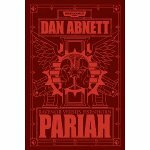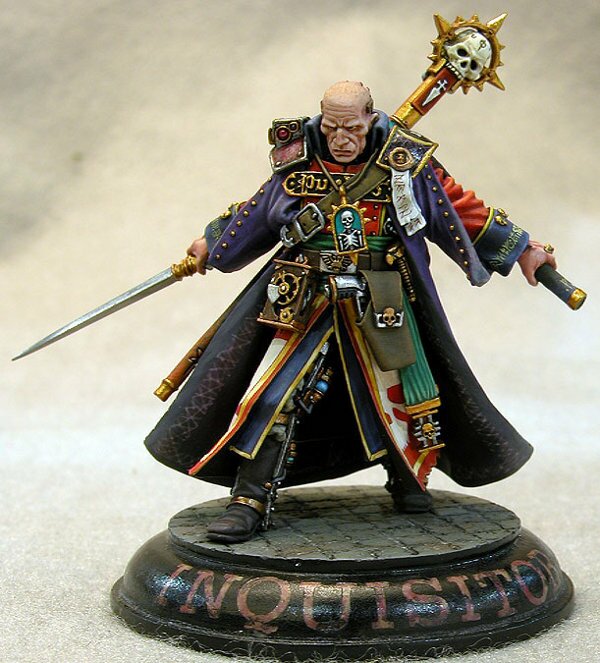 So, I finished Dan Abnett’s latest book: Pariah: Ravenor vs. Eisenhorn. I am not sure how can I really do a review. There have been few times that a book, much less a Warhammer 40K book, left me so conflicted. Pariah is a great book and a great read. It also is a flawed book. Yet nitpicking flaws of Pariah seems a grave injustice to the action- and mystery-packed story Dan Abnett is once again drawing from the 40k universe.
So, I finished Dan Abnett’s latest book: Pariah: Ravenor vs. Eisenhorn. I am not sure how can I really do a review. There have been few times that a book, much less a Warhammer 40K book, left me so conflicted. Pariah is a great book and a great read. It also is a flawed book. Yet nitpicking flaws of Pariah seems a grave injustice to the action- and mystery-packed story Dan Abnett is once again drawing from the 40k universe.
Why Pariah is a Good Book
Pariah is a great book because Dan Abnett is once again writing at the top of his game.
For a novel trying to pick up many of the innumerable strands, pots and sub-plots of the Eisenhorn and Ravenor books and their various spin-offs, such as Perihelion from the recent Games Day Anthology, and set up a new trilogy, the basic story of Pariah is deceptively simple. In many ways, it is but an enormous chase through the city of Queen Mab as the new trilogy’s title character and Pariah Beta Bequin tries to evade the various factions that want to get hold of her for – to her – unknown reasons.
As an action chase, it works very well. The book moves briskly from set to set and from scene to scene, the action keeps coming, the twists keep coming,and there isn’t a lull in the entire book. Mixed into it is all the wonderful, often bizarre and vividly original world-building that Abnett is rightly renowned for. It is both Warhammer 40K and yet a universe very different from the 40K you see from most other authors.
Very few authors can match Abnett’s ability to conjure vivid worlds and settings. Within short 300 pages he turns the city of Queen Mab into a rich, vivid world all of its own, filled with intriguingly named places such as the Maze Undue or the Feverfugue and awesome characters like the “Warblind” or the “Curst”. There is more detail, story and “life” in Queen Mab than in many other fantasy or sci-fi settings in their entirety. And yet Queen Mab is infused with many quintessential Warhammer 40K elements.
A brilliant example is the huge Imperial Temple that serves as the mid-story set for Pariah. The sheer amount of crazy ideas and awe-inspiring word-craft that Abnett put into creating this vista of opulent, decadent, ultimately corrupted worship of the Emperor of Mankind makes the book worth reading all by itself.
That said, Dan Abnett shows no intention of keeping his story confined to a little-known, utterly irrelevant side-planet of the Imperium of Man. If the future books live up to the teasers in this first story, big things are certainly afoot.

Why Pariah is a Flawed Book
There are two problems I had with this book. One are the obtuse references to the Eisenhorn/Ravenor material. The other is how it deals with the title-giving ‘Pariahs’.
Regarding the first. Holy shit. I do consider myself fairly knowledgeable on Abnett’s Inquisition books, but even for me it has been a few years since I read them. If the story of Pariah is a big action-packed chase, than the many factions who chase Beta Bequin are almost all drawn from the Eisenhorn/Ravenor canon. Worse, Abnett does not offer one helping line to any reader who is not intimately familiar with the material down to various side-characters, antagonists and plot-twists from the previous books.
If you want to get the full enjoyment from Pariah, brushing up your Eisenhorn/Ravenor lore is pretty much obligatory. If you don’t, you’ll probably be quite frustrated by the sequence of scenes where Bequin narrowly escapes party A only to stumble into the next trap laid out by party B – without ever being told who these various parties really are.
The second thing that didn’t really work for me was the ‘Pariah’ status. Given the history of Beta Bequin in the Eisenhorn-lore, it is clear that she had to be a Pariah. Nevertheless, the story certainly doesn’t build on it. Quite the opposite, it feels like Dan Abnett had to go through quite a lot of effort to make it all work despite her being a Pariah.
The most obvious addition to the 40K universe are the “cuffs” that allow all Pariahs in the story to “turn off” their blankness (how do you turn off the lack of a warp presence?). Predictably, the “cuff” remains active for virtually the entire story, save one or two action scenes when it is actively used as a convenient anti-psy power of sorts. Yet even with the introduction of these “cuffs” the entire logic behind the Maze Undue of training Pariahs, of all people, as infiltrators and spies that will win the trust of other people seems far-fetched.
Finally and most crucially, the “cuff” seems to contradict most, if not all the problems Pariah’s face in the 40K universe – not least the trouble and story-twists involving Pariahs in the Eisenhorn books. For a book actively named ‘Pariah’, it seems odd that Abnett couldn’t have picked a story that works because of the unique nature of Pariahs in Warhammer 40K, not despite them and only with the help of storytelling trickery.
Who should read Pariah?
The tricky question. Who would enjoy this book?
If you’ve read and like the Eisenhorn and Ravenor books, I would clearly recommend you pick up Pariah. However, Pariah is not a book like the Eisenhorn/Ravenor books. It is different, not least because Dan Abnett tells the story through a less central, non-Inquisitor character. There is thus a lot more mystery throughout the book about what is happening (until, in the showdown, you do get a low-down of things by the Inquisitors). Also, there is actually not (yet) a lot of Eisenhorn and/or Ravenor in the story.
If you haven’t read Eisenhorn and/or Ravenor, it would likely be wiser to read into those books first. That said, I believe it is possible to jump into Pariah without knowing much about the older Inquisitor books from Abnett. Pariah is still a highly entertaining book, full of imaginative places, characters and fast-paced action. It is still a better, more ambitious and imaginative than many other Warhammer 40K novels that are out there.
Pariah: Ravenor vs. Eisenhorn is a flawed book. It is still very much worth reading.









